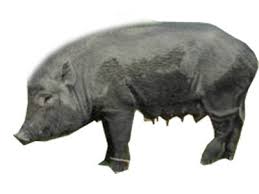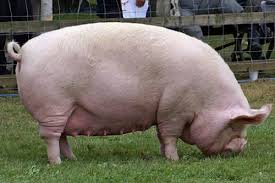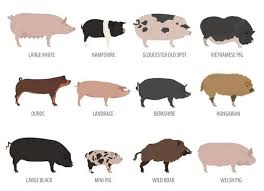There are over 90 recognized breeds of pigs in the world. They can be broadly classified into indigenous or unimproved types and modern exotic types that have been selectively bred for specific commercial purposes.
Read Also: Pumpkin Flowers (Pumpkin Blossoms): Complete Growing and Care Guide
Indigenous Breeds

These breeds are mostly found in developing countries and have evolved various shapes and sizes to survive different environments. Generally, they have smaller and shorter legs than exotic types.
The mature weight of females ranges between 40-120 kg, with the typical unimproved conformation of a large head, well-developed forequarters, and relatively light hindquarters. This structure makes them more mobile and better able to forage and root for themselves.
They mature sexually early, with females showing their first oestrus as early as three months of age. Coat colour varies, with black and brown being the most common, while white is infrequent. The degree of hairiness also varies, with both hairless and long-haired types present.
Bakosi in Cameroon and the Ashanti Dwarf in Ghana are examples of indigenous breeds. Their characteristics include a small body, with mature female sizes ranging from 40-60 kg, and mainly black colour with prick ears.
The unimproved pigs of East, Central, and Southern Africa mostly descend from stock introduced by early European travelers and are relatively widespread rather than truly indigenous. The productivity of these unimproved breeds is influenced by environmental conditions and their typical reproductive performance.
The litter size of indigenous breeds tends to be smaller than improved breeds, but the total live weight of the litter as a proportion of the sow’s weight at farrowing is similar to that of exotic sows.
Read Also: Amazon Flowers: All You Need To Know About
Exotic Breeds of Swine in the Tropics

1. Duroc: This breed has droopy ears and a deep red or rusty colour. It is a fast-growing, large breed that produces an excellent carcass and high-quality meat. It can grow to heavier weights without accumulating excessive fat. The Duroc is a hardy animal well-suited to tropical climates and is commonly used for crossbreeding.
2. Large White (Yorkshire): This breed was first developed in Yorkshire, England. It has erect ears and is white in colour. The females are prolific, and the breed is renowned for its strong legs. It is suitable for both pork and bacon production. Although fairly hardy, it requires protection from sunburn and should be housed appropriately to prevent excessive sun exposure.
3. Landrace: This breed is characterized by its forward-pointing lop ears and a long, smooth body with light shoulders and well-developed hams. It is white in colour and is highly suitable for bacon production. However, it has a higher susceptibility to stress and requires careful management.
4. Hampshire: This breed is black with a distinct white saddle encircling the forequarters. Hampshire pigs are prolific, good mothers, and have excellent milking ability. They produce more meat than Large White and Landrace breeds and are often used for crossbreeding.
5. Tamworth: This hardy breed is reddish in colour with erect ears. It efficiently converts feed but matures relatively slowly. In the past, it has been widely used for crossbreeding in tropical regions.
This article has provided insights into the indigenous breeds of pigs common to tropical countries and the exotic (improved) breeds primarily found in temperate regions. These exotic breeds have been selectively bred and improved over the years for enhanced productivity and commercial benefits in agriculture.
Do you have any questions, suggestions, or contributions? If so, please feel free to use the comment box below to share your thoughts. We also encourage you to kindly share this information with others who might benefit from it. Since we can’t reach everyone at once, we truly appreciate your help in spreading the word. Thank you so much for your support and for sharing!

